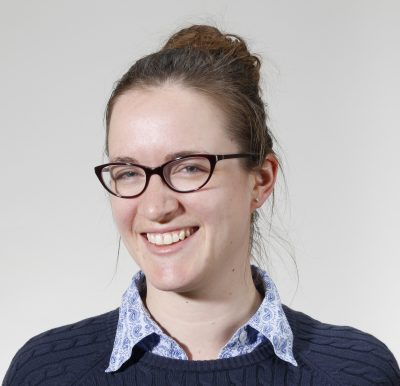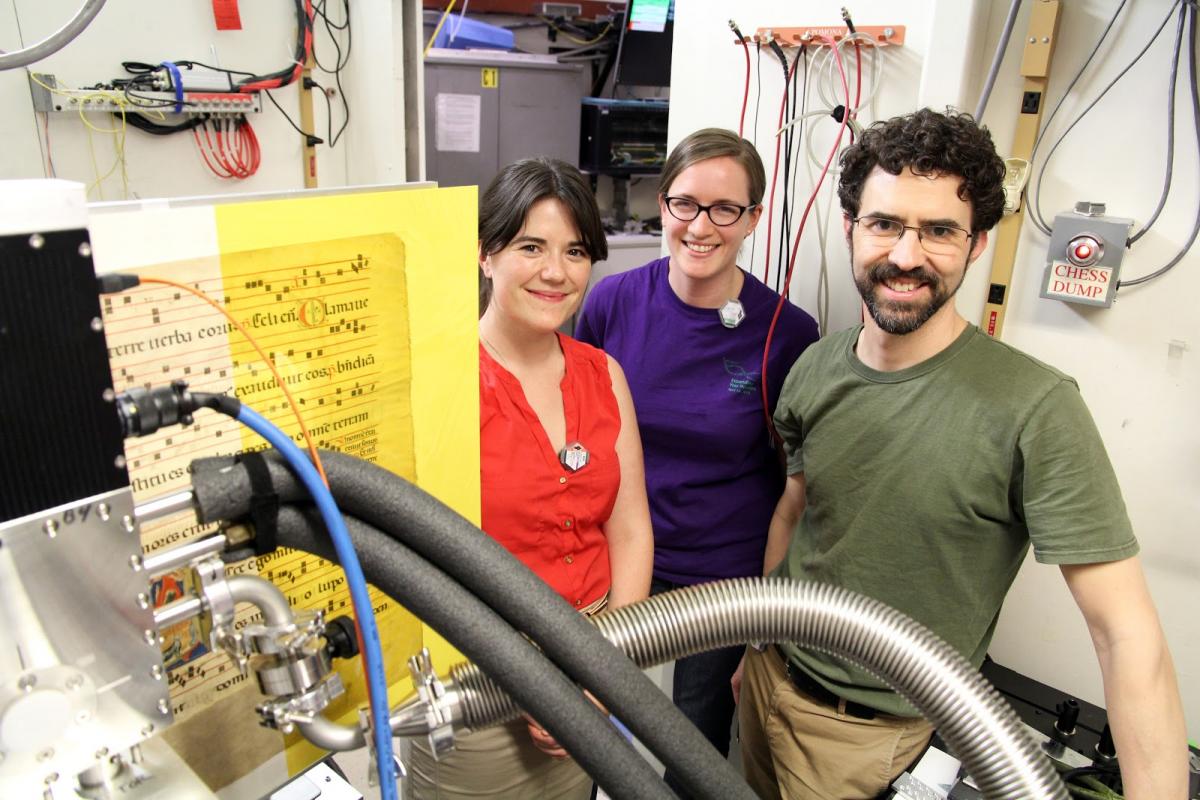Postdoc Spotlight: Louisa Smieska

What is your area of research?
I use a technique called x-ray fluorescence (XRF) to identify which chemical elements are present in objects, without removing samples. Objects studied with XRF can range from plant and animal tissues, to geological and archaeological specimens.
Point XRF measurements can be challenging to interpret, because it is difficult to be sure the points chosen are representative of the whole sample. I specialize in scanning x-ray fluorescence, which means that we make XRF measurements at an array of points above the surface of a flat object. By analyzing the XRF data from each point, we can generate images that show the distribution of different elements in the sample across a large area (square centimeters to meters). These images can be extremely useful for interpreting trends in composition and pinpointing unique areas for further study.
Most recently, I have been working on applications of scanning XRF for the study of art objects such as paintings, illuminated manuscripts, and 19th/early 20th century photographs. Elemental composition information allows us to infer the identities of many inorganic compounds, making it very relevant for historic pigments, which were often made directly from minerals or synthesized from metallic compounds.
Why is this research important?
I get asked a lot if scanning XRF of artwork is used to detect forgeries. While XRF analysis can determine whether the materials used are consistent with the attributed time period, this information by itself is not enough to confirm or refute the status of an artwork.
Many of the artwork-related questions that scanning XRF is used to address have to do with the relationship between the object’s current appearance and the artist’s intent. In paintings, artists frequently made changes to their compositions or even painted entirely new images on top of rejected or unfinished paintings. If the paint compositions in the upper and lower layers are sufficiently different, scanning XRF can help to see through the upper layers to buried compositions.
It is also important to think about whether the appearance of artwork today is as it was when the artist created it. Not only does varnish darken and yellow over time, but some pigments can darken, fade, or even change color over time. Scanning XRF measurements have been used to understand the chemical processes that lead to color changes and pigment degradations, as well as to virtually estimate a reconstruction of the original appearance.
I am particularly interested in XRF analysis of trace elements in art materials. If unique trace element compositions can be linked to specific geographic sites, it may be possible to determine where mineral objects or pigments were mined. This information can help us understand historic trade routes, as well as to link objects, like manuscript pages, that were once part of the same context but are now held in different collections.
What inspired you to choose this field of study?
This field is a synthesis of many of my interests. I have always loved art, and I had a double major in chemistry and the fine arts as an undergraduate at Hamilton College. I’ve also been interested in chemical imaging—my graduate work in the Marohn Group in the Cornell Chemistry Department involved mapping charges in different organic semiconductor devices to learn about relationships between device performance and chemical degradation.
I learned about the field of technical analysis of cultural heritage in a lecture at the Johnson Museum by Prof. Margaret Holben Ellis from the NYU Institute of Fine Arts conservation program. Her presentation showed how chemical analysis was being used to understand works on paper. It was a revelation to see familiar techniques being applied to such unexpected objects.
I understand that you’ve been involved with the Johnson Museum, including taking courses as part of the museum’s “Connecting Research with Practice” initiative. What inspired you to take these courses?
Yes, I was a student in three of these interdisciplinary courses: “From Excavation to Exhibit,” “Curatorial Practice Today,” and “Art|Science Intersections.” I was lucky to speak with Prof. Ellis after her lecture, and she encouraged me to pursue coursework in art history. This nudged me to seek out upcoming courses, and I was fortunate to have the support of Prof. Marohn, my graduate advisor, in pursuing that coursework alongside my research responsibilities.
I was very nervous about approaching humanities courses as a graduate student in chemistry. In the beginning of that first semester, I am not sure I would have followed through without my husband’s constant encouragement to take the risk. Looking back, both the art history department and the Johnson Museum have been incredibly welcoming, and I would encourage other students to explore the great opportunities at Cornell for interdisciplinary study.
How has your involvement with the Johnson Museum influenced your thinking as a researcher or scholar?
The Johnson Museum courses provided a strong interdisciplinary foundation for understanding generally how museums operate and introduced me to contemporary museum studies best practices. These courses also familiarized me with the critical theories and ethical questions that guide conservators in their treatments and lead the curators in their research and presentation of objects. I feel that having a sensitivity to these theories and questions has made it easier to communicate and collaborate with my colleagues in the humanities.
More generally, scientists often pride ourselves on our methods of observation and analytical thinking. It has been a challenge, and a delight, to learn to apply these skills in a new way, and to develop new ways of seeing. I have a much deeper appreciation for the labor behind a mature connoisseur’s eye, and I feel this experience has also encouraged much more resilience in my scientific thinking.

Another way the Johnson Museum courses have very directly influenced my research is by introducing me to many people from a variety of disciplines who are now my colleagues. For example, Ruth Mullett (Medieval studies) was my fellow student in the curatorial practicum, and is now my collaborator and co-author in research on illuminated manuscript pigments. These courses also involved field trips to conservation labs at the Met and the Morgan Library in New York, experiences that encouraged me to apply for my current fellowship. Drawing on my experiences in previous courses as well as an interest in image processing, last year I even had a chance to contribute to a new Johnson Museum course on watermarks in Rembrandt prints taught by wonderful mentors Andy Weislogel and Rick Johnson. And I never expected to find a position doing x-ray science through an art museum, but the Art|Science Intersections course introduced me to Arthur Woll at the Cornell High Energy Synchrotron Source (CHESS), who became my advisor while I was a postdoc working on scanning XRF last year.
I understand you’re currently a Mellon Foundation Conservation Fellow at the Metropolitan Museum of Art. What have you been working on in this role?
I am working with a laboratory-based XRF scanning system housed in the paintings conservation department at the Met. Having the ability to make scanning XRF measurements in the museum rather than at a synchrotron is relatively new, so a significant part of my role here is improving data analysis protocols. The instrument is primarily used to study paintings in the Met’s collections, but I have also been able to contribute to ongoing collaborative research efforts, like the APPEAR project, a multi-museum technical examination of funerary portraits from Roman Egypt.
In my independent research, I am exploring applications of scanning XRF for the study of other 2D objects, particularly 19th/early 20th century photographs. There are enormous variations in the chemistry of photographic processes that are difficult to assess by eye, but strongly influence how the objects should be treated. Examining photographs with point XRF is also challenging because there is not very much inorganic material present to measure, so I am evaluating what role scanning XRF might play in examination of photographs.
How do you think this fellowship will shape your research and your career future?
Both CHESS and the Met are exciting places to work. I miss the team at CHESS as well as the synchrotron’s unique combination of experimental flexibility and sensitivity. On the other hand, the opportunity to work with the extraordinary collections at the Met is unbelievable. Many of these objects will probably never visit a synchrotron, so it’s important to improve the methods museums can use onsite. I’m hopeful that I will find a way to continue research in the cultural heritage field that takes advantage of both lab-based and synchrotron-based experiments.
Interview by Sally Kral, communications and outreach assistant in the Graduate School
